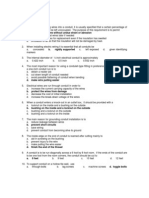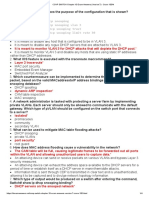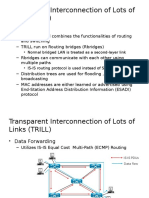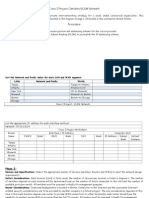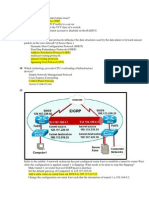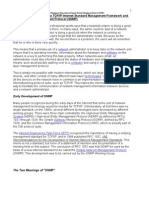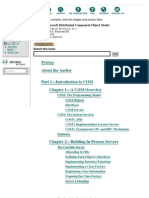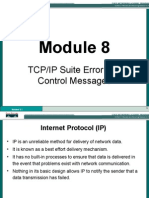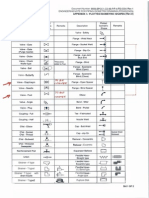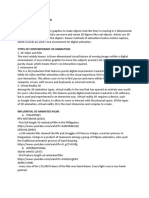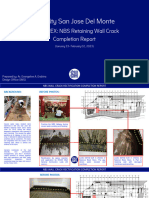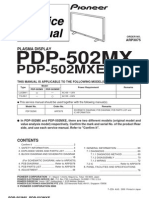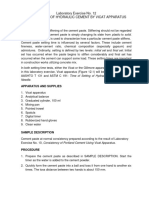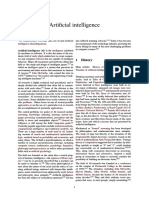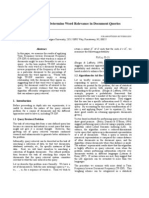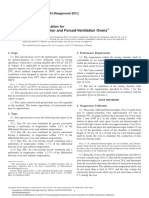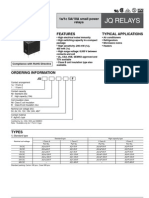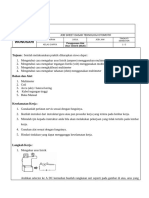Internet Protocol
Internet Protocol
Uploaded by
Mark Lester PicazoCopyright:
Available Formats
Internet Protocol
Internet Protocol
Uploaded by
Mark Lester PicazoCopyright
Available Formats
Share this document
Did you find this document useful?
Is this content inappropriate?
Copyright:
Available Formats
Internet Protocol
Internet Protocol
Uploaded by
Mark Lester PicazoCopyright:
Available Formats
7/14/2011
IP
The Internet Protocol (IP)
Refers to as the heart and soul of TCP/IP
Receives data bits from lower layers Assembles into packets (IP datagrams) Routes the packets between nodes
Connectionless where every datagram contains destination address (IP address) IP address uniquely identifies the host Fragments and reassembles datagrams as necessary so as not to exceed the Maximum Transmission Unit (MTU) a physical network supports Reassembly takes place only in the destination node
IP
IP
IP gateways refers to switches and routers Routing table is maintained by each IP gateway which helps determine the route of the datagram Hop when the datagram passes through h h d h h an intermediate gateway Cost computed by using pseudocost Least Cost / Least Hop is used for determining the routing algorithm of datagram
Within a network, datagrams are delivered directly (LAN 1)
Uses switches, routers, etc to receive datagrams from LAN 1 (LAN 2)
IP
Uses Internet Control Message Protocol (ICMP) to help determine flow-control and other network related problems such as destination p node is unreachable (host unreachable or network unreachable) Example of ICMP application is ping command
Address Resolution Protocol
It maps the IP address to the physical machine Uses a table called ARP cache Uses separate ARP specifications for Ethernet, Frame Relay and other protocols
7/14/2011
Reverse Address Resolution Protocol
Used to get the IP address from a map table of the corresponding MAC address of the specific node Used b b t not limited to Ethe net by but Ethernet and token ring
Protocol Structure : ARP and RARP
16 32 bit
Hardware Type
Protocol Type
HLen
Plen
Operation
Sender Hardware Address
Sender Protocol Address
Target Hardware Address
Target Protocol Address
Protocol Structure
Hardware type - Specifies a hardware interface type for which the sender requires a response. Protocol type - Specifies the type of high-level protocol address the sender has supplied. Hlen - Hardware address length. Plen - Protocol address length. Operation - The values are as follows:
ARP request. qu ARP response. RARP request. RARP response. Dynamic RARP request. Dynamic RARP reply. Dynamic RARP error. InARP request. InARP reply.
Type
Protocol Structure : Hardware Type
10 Description 11 12 1 2 3 4 5 6 7 8 9 Ethernet. Experimental Ethernet. Ethernet Amateur Radio AX.25. 16 Proteon ProNET Token Ring. 17 Chaos. IEEE 802. ARCNET. Hyperchannel. 22 Lanstar. MIL-STD-188-220. 18 19 20 21 HDLC. Fibre Channel. ATM, Asynchronous Transmission Mode. Serial Line. ATM, Asynchronous Transmission Mode. ATM, Asynchronous Transmission Mode. 28 HIPARP. 13 14 15 Autonet Short Address. LocalTalk. LocalNet (IBM PCNet or SYTEK LocalNET). 25 Ultra link. SMDS. Frame Relay. 26 27 Twinaxial. EUI-64. MAPOS. 23 24 Metricom. IEEE 1394.1995.
Sender hardware address -HLen bytes in length. Sender protocol address - PLen bytes in length. Target hardware address - HLen bytes in length. Target protocol address - PLen bytes in length.
Resource Reservation Protocol (RSVP)
is part of TCP/IPs network layer whereas function also as Quality of Service protocol De eloped by Internet Engineering Developed b Inte net Enginee ing Task Force (IETF) Prioritize data with sufficient bandwidth for transfer e.g. videoconferencing
IP Address
Class A
Network Address + Class Type bits
Host ID
Class B
Hosts = 16,777,216 First Octect = 0 to 127 Hosts = 65,536 First Octect = 128 to 191 Hosts = 256 First Octect = 192 to 223
8 bits (0 to 7 bit)
24 bits
16 bits (0 to 15 bit)
16 bits
Class C Cl
24 bits (0 to 23 bit)
8 bits
Class D Class E
Reserved for Multicast From 224.0.0.0 to 239.255.255.255
Reserved for future use/Research and Development Purposes. from 240.0.0.0 to 254.255.255.254
7/14/2011
IP Address
Made up of 4 octets or 32 bits separated by a dot each octet e.g. 11000000.10101000.0.00000001 Fo easie reading, each octet is For easier eading ea h o tet converted into decimal form e.g. 192.168.0.1
Subnetting
Use logical AND 11000000.10101000.00000000.11001000 192.168.000.200 Class B IP Address 11111111.11111111.11111111.00000000 255.255.255.000 Default Class B Subnet Mask ------------------------------------------------------------------11000000.10101000.00000000.00000000 192.168.000.000 Network Address 000000 0 0 000 00000000 00000000 9 68 000 000 o dd 11000000.10101000.11111111.11111111 192.168.255.255 Broadcast Address | host id | reverse all zeroes in host id Broadcast address Default subnet masks: Class A - 255.0.0.0 - 11111111.00000000.00000000.00000000 Class B - 255.255.0.0 - 11111111.11111111.00000000.00000000 Class C - 255.255.255.0 - 11111111.11111111.11111111.00000000
Subnetting
For example, you are given the following :
network address : 192.168.25.0 Hosts : 60 One reserved for Network Address One reserved for Broadcast Address
Subnetting
Change to bits : 11000000.10101000.00011001.00000000 192.168.25.0 11111111.11111111.11111111.00000000 255.255.255.0 Extend Subnet Mask bits into host bits, in this case since we need 60 , hosts, then up to the bit representing 64 in decimal form 11111111.11111111.11111111.11000000 255.255.255.192 (new subnet mask)
can also be written as 192.168.25.0/26 Additional 2 bits indicates it is divided into 4 subnetworks (22 = 4) Remaining 6 bits in the host id part indicates that it can have 62 hosts plus one network address and broadcast address which totals to 64 (26 = 64)
Subnetting
Network Address 192.168.25.0 192.168.25.64 192.168.25.128 192.168.25.192 Hosts 1 to 62 65 to 126 129 to 190 193 to 254 Broadcast Address 192.168.25.63 192.168.25.127 192.168.25.191 192.168.25.255
Multicasting
One sender, selected group of receiver Still new to the Internet, basically for multimedia streaming New protocols developed :
Hierarchical Distance Vector Multicast Routing Protocol (HDVMRP) Multicast Border Gateway Protocol Independent Multicast
With Subnet Mask of 255.255.255.192
7/14/2011
Multicasting
Samples of IP addresses used for Multicasting :
224.0.0.1 = 224.0.0.2 224 0 0 2 = 224.0.1.1 = 224.0.0.9 = 224.0.1.2 = application All systems on the subnet All routers on the subnet Network time protocol (NTP) For RIPv2 Silicon graphic's dogfight
Broadcasting
One sender, all receiver Types of Broadcast :
ARP on IP DHCP on IP Routing table updates. Broadcasts sent by routers with routing table updates to other routers. Limited Broadcast - Sent to all NICs on the some network segment as the source NIC. It is represented with the 255.255.255.255 TCP/IP address. This broadcast is not forwarded by routers so will only appear on one network segment. Direct broadcast - Sent to all hosts on a network. Routers may be configured to forward directed broadcasts on large networks. For network 192.168.0.0, the broadcast is 192.168.255.255.
Methods :
References
Gallo, M. A. & Hancock, W. M. (2002). Computer Communications and Networking Technologies. California : Brooks/Cole. Computer Hope (n.d.). IP. Computer Hope. Retrieved July 14, 2011, from http://www.computerhope.com/jargon/i/ip.htm. Javvin (n.d.) RARP: Reverse Address Resolution Protocol. Javvin: Network Management and Security. http://www.javvin.com/protocolRARP.html. Network Sorcery (n.d.). RARP: Reverse Address Resolution N t kS ( d ) RARP R Add R l ti Protocol. Network Sorcery. http://www.networksorcery.com/enp/protocol/rarp.htm. Becker, Ralph (January 31, 2007). Subnetting. Ralphb. Retrieve July 14, 2011, from http://www.ralphb.net/IPSubnet/subnet.html. Comptechdoc (n.d.). Network Broadcasting and Multicasting. Comptechdoc. Retrived July 14, 2011, from http://www.comptechdoc.org/independent/networking/guide/netbr oadcasting.html.
You might also like
- QNA For Master ElectricianDocument49 pagesQNA For Master ElectricianJanry Quiñones75% (12)
- Networking 101 Back To Basics SlidesDocument26 pagesNetworking 101 Back To Basics SlidesEthio DotNetDeveloperNo ratings yet
- 07-BCMSN-Layer 3 Switching PDFDocument7 pages07-BCMSN-Layer 3 Switching PDFChoubane LamineNo ratings yet
- Manh Met Warehouse Management Open System Training en UsDocument8 pagesManh Met Warehouse Management Open System Training en UsRidwan Alfarisy0% (1)
- Network with Practical Labs Configuration: Step by Step configuration of Router and Switch configurationFrom EverandNetwork with Practical Labs Configuration: Step by Step configuration of Router and Switch configurationNo ratings yet
- 02 MK-PPT ApplicationsDocument97 pages02 MK-PPT ApplicationsHaftamu HailuNo ratings yet
- Computer Networks: SSTM Mba - CabDocument23 pagesComputer Networks: SSTM Mba - CabRevathy NairNo ratings yet
- Unit4 - 6Document37 pagesUnit4 - 6api-26313100No ratings yet
- CCNP SWITCH Chapter 10 Exam Answers (Version 7) - Score 100%Document4 pagesCCNP SWITCH Chapter 10 Exam Answers (Version 7) - Score 100%GC ToolbarNo ratings yet
- Cisco IOS Zone Based Firewall TutorialDocument12 pagesCisco IOS Zone Based Firewall TutorialuseryonNo ratings yet
- 2013 10 03 NetFlow JiriTesarDocument38 pages2013 10 03 NetFlow JiriTesarnomoxpsNo ratings yet
- Latest Version - CCNP Route - 300-101 - Version 2018 - 91q - Prince-V1 PDFDocument33 pagesLatest Version - CCNP Route - 300-101 - Version 2018 - 91q - Prince-V1 PDFtho anhNo ratings yet
- Introduction of OTV in NexusDocument62 pagesIntroduction of OTV in Nexussukant1980No ratings yet
- Ipv6 Technology: Cisco PublicDocument123 pagesIpv6 Technology: Cisco PublicsandyinsNo ratings yet
- Cemdt 172Document2 pagesCemdt 172zubairNo ratings yet
- BRKNMS 3134 PDFDocument155 pagesBRKNMS 3134 PDFpaulo_an7381No ratings yet
- BRKCRS 2000Document73 pagesBRKCRS 2000PankajNo ratings yet
- Chapter 1 - Introduction To Network SecurityDocument25 pagesChapter 1 - Introduction To Network Securitybusiness dealNo ratings yet
- 10 7302 5523 Operator RSTP NTredundancyDocument36 pages10 7302 5523 Operator RSTP NTredundancybelbel4321No ratings yet
- Transparent Interconnection of Lots of Links (TRILL) : - OverviewDocument19 pagesTransparent Interconnection of Lots of Links (TRILL) : - OverviewNikhil SharmaNo ratings yet
- Chapter 10: Application Layer: Instructor MaterialsDocument39 pagesChapter 10: Application Layer: Instructor MaterialsleyleyNo ratings yet
- Cisco IOS Software Release 15.0 (1) MDocument84 pagesCisco IOS Software Release 15.0 (1) MBenjamin LewisNo ratings yet
- Intrusion Detection, Firewalls, and Intrusion PreventionDocument52 pagesIntrusion Detection, Firewalls, and Intrusion PreventionkhandeshaNo ratings yet
- Design Network Inf - Tut 3Document20 pagesDesign Network Inf - Tut 3Rupesh PandeyNo ratings yet
- Module 3: Protocols and Models: Instructor MaterialsDocument66 pagesModule 3: Protocols and Models: Instructor MaterialsFernandoAsinNo ratings yet
- 4.1.1.7 Lab - Tracing A RouteDocument3 pages4.1.1.7 Lab - Tracing A Routeshalen100% (2)
- Cisco 1 ProjectDocument5 pagesCisco 1 ProjectAyoub Sahri0% (1)
- Wide-Area NetworksDocument68 pagesWide-Area NetworksGorvam SaddarNo ratings yet
- NetworksDocument20 pagesNetworksshivam100% (1)
- CCNP TSHOOT Chap9Document8 pagesCCNP TSHOOT Chap9jocdocNo ratings yet
- CCNA CoN Chapter 7 Practice Skills Assessment - PTDocument4 pagesCCNA CoN Chapter 7 Practice Skills Assessment - PTChristopher GrayNo ratings yet
- TCP IpDocument16 pagesTCP Ipnithin_mampillyNo ratings yet
- Ipsec PresentationDocument40 pagesIpsec PresentationBon Tran HongNo ratings yet
- SNMPDocument43 pagesSNMPapi-3716512No ratings yet
- BRKSEC2004Document214 pagesBRKSEC2004DC FanNo ratings yet
- Puter NetworksDocument28 pagesPuter Networkswaleed.khaldNo ratings yet
- CCNA Chapter7 Eigrp - OSPFDocument73 pagesCCNA Chapter7 Eigrp - OSPFSalmaanCadeXaajiNo ratings yet
- Cis185 ROUTE Lecture2 EIGRP Part1Document104 pagesCis185 ROUTE Lecture2 EIGRP Part1Phil GarbettNo ratings yet
- Network ProtocolsDocument20 pagesNetwork ProtocolsKamesh SjNo ratings yet
- Network SocketsDocument28 pagesNetwork SocketsPeter R. Egli100% (2)
- Cisco1 OSI Layer MindMapDocument1 pageCisco1 OSI Layer MindMapKhien HuynhNo ratings yet
- Introduction To Computer NetworksDocument30 pagesIntroduction To Computer NetworksAnamithra KNo ratings yet
- Deploying Performance RoutingDocument96 pagesDeploying Performance RoutingSalis AlvarezNo ratings yet
- DC&N Lab ManualDocument59 pagesDC&N Lab ManualAsif MuhammadNo ratings yet
- Secospace USG2000Document6 pagesSecospace USG2000Utopia MediaNo ratings yet
- CCNA1 v5 + v5.02 Final Exam Answers: LAN MAN WlanDocument37 pagesCCNA1 v5 + v5.02 Final Exam Answers: LAN MAN WlanIon CaramanNo ratings yet
- DSG Tutorial Vendor Briefing 2004-04Document83 pagesDSG Tutorial Vendor Briefing 2004-04Johnniequest Queens BestNo ratings yet
- © 2002, Cisco Systems, Inc. All Rights ReservedDocument39 pages© 2002, Cisco Systems, Inc. All Rights ReservedRajNo ratings yet
- Tshoot Chapter1 SolutionDocument7 pagesTshoot Chapter1 Solutionawersdf40% (5)
- ENSA Module 10 Network ManagementDocument81 pagesENSA Module 10 Network ManagementMerry margaretha wijayaNo ratings yet
- Chapter 3. Fundamentals of WAN and IP RoutingDocument19 pagesChapter 3. Fundamentals of WAN and IP RoutingPoojitha NagarajaNo ratings yet
- Chapter 4: Network Access: Instructor MaterialsDocument55 pagesChapter 4: Network Access: Instructor MaterialsMohammad MazenNo ratings yet
- Multiple Spanning Tree ProtocolDocument7 pagesMultiple Spanning Tree ProtocolPadam DhamiNo ratings yet
- DCOM Microsoft Distributed Component Object ModelDocument392 pagesDCOM Microsoft Distributed Component Object Modelstevenronald3136No ratings yet
- TCP/IP Suite Error and Control MessagesDocument28 pagesTCP/IP Suite Error and Control MessagesbaraynavabNo ratings yet
- SSL, TLS, Ciphers Oh MyDocument3 pagesSSL, TLS, Ciphers Oh Mybalamurali_aNo ratings yet
- Performance Routing PFRDocument28 pagesPerformance Routing PFRrockerptitNo ratings yet
- Chapter1 - Part 1 SWDocument36 pagesChapter1 - Part 1 SWAsy RafNo ratings yet
- Transmission Control Protocol / Internet ProtocolDocument29 pagesTransmission Control Protocol / Internet Protocolkritagya chandraNo ratings yet
- Configuring IPCop Firewalls: Closing Borders with Open SourceFrom EverandConfiguring IPCop Firewalls: Closing Borders with Open SourceNo ratings yet
- SHW BrochureDocument4 pagesSHW Brochurelaboratoriocgssa cgssa100% (1)
- Rfi Novec R7&R8Document2 pagesRfi Novec R7&R8MOSTAFA SHARAFNo ratings yet
- IsometricDocument7 pagesIsometricmumNo ratings yet
- History of 3D Animation Brief ExplanationDocument2 pagesHistory of 3D Animation Brief ExplanationAvery VillaNo ratings yet
- Cxd2830r (DTMB DVB-C)Document2 pagesCxd2830r (DTMB DVB-C)Deepu GopinathanNo ratings yet
- Shell Rimula R6 LM 10W-40Document2 pagesShell Rimula R6 LM 10W-40MichaelNo ratings yet
- Scaffolding Inspection GuideDocument1 pageScaffolding Inspection Guiderickymma100% (1)
- NBS Retaining Wall Crack Rectification Completion ReportDocument8 pagesNBS Retaining Wall Crack Rectification Completion ReportEvangeline Anting EndrinaNo ratings yet
- Plasma DisplayDocument83 pagesPlasma DisplayPET33400No ratings yet
- 24 Lathe Machine Parts and Functions PDFDocument8 pages24 Lathe Machine Parts and Functions PDFTackle XINo ratings yet
- LabEx No. 12 Setting Time of Hydraulic Cement Using Vicat ApparatusDocument4 pagesLabEx No. 12 Setting Time of Hydraulic Cement Using Vicat ApparatusGerman BarlisNo ratings yet
- 1.060 ATP 2023-24 GR 11 Mech Tech Aut FinalDocument4 pages1.060 ATP 2023-24 GR 11 Mech Tech Aut FinalNigel EvertsonNo ratings yet
- Artificial IntelligenceDocument31 pagesArtificial IntelligenceKostasBaliotisNo ratings yet
- Magnescann Pipetronics Trap DimensionsDocument20 pagesMagnescann Pipetronics Trap DimensionsChike NwachukwuNo ratings yet
- As Built de Rede de ComputadoresDocument12 pagesAs Built de Rede de ComputadoresJosé HenriqueNo ratings yet
- TF Idf AlgorithmDocument4 pagesTF Idf AlgorithmSharat DasikaNo ratings yet
- NASM35308Document3 pagesNASM35308peter geltserNo ratings yet
- Electronic Cabinet-LocksDocument12 pagesElectronic Cabinet-Locksjeff.markleNo ratings yet
- MSC Code All OperatorDocument87 pagesMSC Code All OperatorParmar Nilesh0% (1)
- Boeing 737Document7 pagesBoeing 737Christine MonroeNo ratings yet
- Course Contents For Fall Semester-1Document25 pagesCourse Contents For Fall Semester-1Muhammad HussainNo ratings yet
- Astm E145Document2 pagesAstm E145Lawrence Enriquez SerranoNo ratings yet
- PCB ProjectDocument3 pagesPCB Projectemeraldlights2No ratings yet
- Solid State / Crystalline State ChemistryDocument26 pagesSolid State / Crystalline State ChemistrymyiitchemistryNo ratings yet
- Manhole Inspection Report: Asset Information Inspection InformationDocument6 pagesManhole Inspection Report: Asset Information Inspection Informationjohnsel92No ratings yet
- Relè PanasonicDocument6 pagesRelè PanasonicsdfjksdhfkljsNo ratings yet
- STK4162IIDocument9 pagesSTK4162IIFredy Reinaldo Rivera MartínezNo ratings yet
- Job Sheet MultimeterDocument4 pagesJob Sheet MultimeteruntungNo ratings yet
